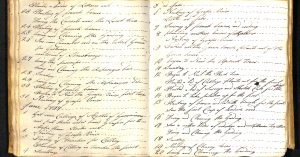Thomas Challis (1777-1845) Undergardener at Audley End, Essex
A handful of gardener’s diaries survive from the long-nineteenth century, though most of these date from at least the middle of the century. Thomas Challis’ diary, written between 1792 and his death in 1845 is particularly rare. It was acquired in 2019 by English Heritage and has been a central primary source in the writing of my PhD thesis about the building, maintaining, use and engagement with Georgian country house gardens.
Thomas Challis was born in October 1777 at Kirtling, Cambridgeshire. Aged fourteen, Challis left home to live and train as an apprentice under a Mr. Mail at Cheveley Park, near Newmarket. In the summer of 1795, he had completed his apprenticeship and took a position as undergardener at Audley End where he stayed until Spring 1798. The bulk of the dated material of his notebook is concentrated on this time. Between 1798 and 1810 Challis was employed at nine different establishments, four of which were nurseries in and around London. In 1810 he took his final position as head gardener at Standlynch Park which eventually came to be gifted to Lord Nelson’s family and was occupied by his brother. This biographical detail of his career is outlined at the very front of the diary, added to throughout his life as his circumstances changed. At the back, and upside down, is a summary of personal life events, some of which were recorded by his son after his death in 1845. It shows a life full of joys and sorrows, births, two marriages, and several close family bereavements.
The diary gives us a lot of valuable information about his working life. His detailed record-keeping allows us to explore the day-to-day work performed by a trainee gardener. The key feature of the document is around three years’ worth of daily work records. Every day he wrote a short statement of the work done that day (Fig. 1). Unsurprisingly, the work was seasonal with planting and harvesting certain plants happening at a similar time year-to-year. Fruit trees, for example, were pruned and nailed every six months or so, and potatoes and apples were harvested in the early autumn. Some of the most frequent tasks for Challis was tending fruit trees, particularly peaches and nectarines grown against walls heated by furnaces and flues, and the cucumbers and melons grown in specialised glass frames. Some were more time-consuming than others. On 29th March 1797 he sowed nine different crops of plants including salsify, cabbages, broccoli, and celery. Sowing was undoubtedly a more efficient task than harvesting as by October, gathering the apples and taking up the potatoes was completed almost every day for a month. The great variety of tasks Challis was assigned shows how much knowledge an individual gardener could, and indeed should, acquire through the early stages of his career. These records would have been a valuable resource to him to reflect on his time at Audley End, perhaps in subsequent employment positions.
So far in my thesis I have examined the expenditure and supply that built and maintained gardens, and the lives of the people that worked in and adjacent to country house gardens. This diary has been incredibly useful in contextualising the process of growing food for the house as well as bringing a human story into a project that has so far been dominated by economic records in which only names of labourers appear.
Future chapters of my thesis focus on how country house gardens were used as a recreational space and how these spaces were experienced sensorially and emotionally.
Helen Brown, Manchester Metropolitan University. “Rethinking the Country House Garden: Creation and Consumption, 1750-1850”
